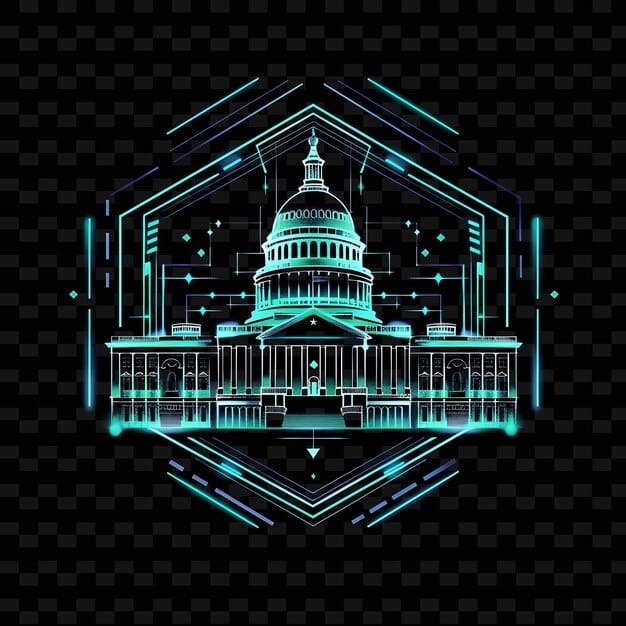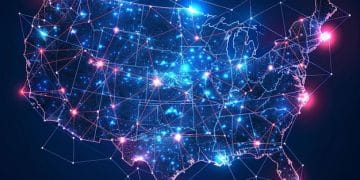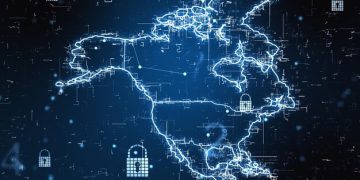Decoding New US AI Policy: 3 Key Changes Exposed

The latest US AI policy introduces three fundamental shifts in governance, aiming to balance innovation with critical safeguards for privacy, security, and ethical development, impacting every American citizen.
In a world rapidly reshaped by artificial intelligence, understanding its governance becomes paramount. The United States, a global leader in technological advancement, has recently unveiled critical updates to its AI policy. These changes aren’t just bureaucratic jargon; they represent a significant pivot in how AI will be developed, deployed, and regulated across the nation, directly influencing daily life and the future of work. This article will delve into decoding the new US AI policy: 3 key changes every citizen should know, exploring their implications and what they mean for you.
The Push for Responsible AI Innovation
The new US AI policy places a strong emphasis on fostering innovation while simultaneously ensuring that AI development occurs responsibly. This duality reflects a growing global consensus that unchecked technological advancement can lead to unintended consequences. The government’s approach seeks to establish guardrails that protect against potential harms without stifling the economic and societal benefits AI promises.
One of the core tenets of this responsibility framework is the concept of “AI Bill of Rights.” While not a legally binding document in the traditional sense, it outlines principles intended to guide the design, use, and deployment of AI systems. These principles underscore the importance of transparency, accountability, and fairness, laying a ethical groundwork for the technology’s evolution.
Implementing Ethical Guidelines
Government agencies and private sector companies are encouraged, and in some cases mandated, to adopt these ethical guidelines. This includes:
- Data Privacy Protection: Ensuring personal data used by AI systems is collected, stored, and processed securely and ethically.
- Algorithmic Fairness: Preventing AI algorithms from perpetuating or exacerbating societal biases, particularly in critical areas like employment, credit, and criminal justice.
- Human Oversight: Maintaining a degree of human control and intervention over AI systems, especially those with high-stakes applications.
The push for responsible innovation isn’t merely about regulation; it’s about shifting the cultural mindset within the AI development community. It urges developers to consider the broader societal impact of their creations from the earliest stages of design. This proactive stance aims to prevent issues rather than reacting to them after they manifest. For citizens, this translates to an expectation of safer, more equitable AI experiences, though vigilance remains crucial.
This initial change underscores a fundamental shift from a hands-off approach to one that actively shapes the AI landscape. It acknowledges both the immense potential and the significant risks associated with AI, asserting a federal role in steering its development towards beneficial outcomes for all Americans. The implications extend far beyond pure technology, touching on civil liberties, economic opportunity, and national security.
Enhanced National Security and Cybersecurity
Artificial intelligence, while a powerful tool for progress, also presents new vectors for national security threats and cybersecurity vulnerabilities. The second key change in the US AI policy focuses intently on fortifying national defenses against AI-enabled risks, from sophisticated cyberattacks to manipulation campaigns.
The policy recognizes that adversaries could weaponize AI to enhance their offensive capabilities, making traditional defensive mechanisms insufficient. Therefore, there’s a significant investment in developing AI-powered cybersecurity tools and strategies to counter these emerging threats. This includes advanced anomaly detection, predictive threat intelligence, and automated response systems tailored to outpace malicious AI.

Protecting Critical Infrastructure
A major concern is the protection of critical infrastructure, such as energy grids, financial systems, and transportation networks, from AI-driven attacks. The new policy mandates increased collaboration between government agencies and private sector entities operating these vital systems. Information sharing, joint training exercises, and rapid incident response protocols are being strengthened to create a more resilient national defense posture.
- Supply Chain Security: Implementing stringent checks on AI hardware and software supply chains to prevent the introduction of malicious backdoors or vulnerabilities.
- Counter-Disinformation Efforts: Developing AI tools to identify and neutralize foreign AI-powered disinformation campaigns that seek to undermine democratic processes or public trust.
- Defense Applications: Investing in ethical and safe development of AI for defense purposes, including autonomous systems, while adhering to international norms and laws.
The proactive stance against AI-enabled threats acknowledges that the battleground of the future will increasingly be digital. This isn’t just about protecting government secrets; it’s about safeguarding the very fabric of society from disruptions caused by malicious AI actors. For citizens, this translates into a heightened sense of security in their digital interactions and the continued reliability of essential services, though it also requires an understanding of how their own digital behaviors might contribute to overall national resilience.
The policy’s emphasis on national security underscores the dual-use nature of AI technology. While it promises immense benefits, its misuse could have catastrophic consequences. By prioritizing security, the US aims to maintain its strategic advantage in the global AI race while mitigating the inherent risks. This comprehensive approach signals a maturation in how the government views AI—not just as a technological frontier, but as a critical domain of national power and defense.
Establishing Clear Regulatory Frameworks
Perhaps the most impactful shift introduced by the new US AI policy is the concerted effort to establish clear and adaptable regulatory frameworks. For years, AI development has largely operated in a regulatory vacuum, leading to uncertainty for businesses and potential risks for the public. This third key change aims to provide much-needed clarity and oversight, transitioning from a reactive to a more proactive governance model.
The policy advocates for a sector-specific approach to regulation, acknowledging that a one-size-fits-all solution is impractical given the diverse applications of AI. This means that AI used in healthcare will face different regulations than AI used in finance or transportation, ensuring that rules are tailored to the specific risks and opportunities of each industry.
A critical component of this framework is the development of AI testing and evaluation standards. These standards will provide a common methodology for assessing the performance, reliability, and safety of AI systems before they are deployed. The goal is to ensure that AI technologies meet minimum quality and safety benchmarks, fostering greater public confidence and mitigating unforeseen failures.
Key Regulatory Focus Areas
The regulatory push will concentrate on several vital areas:
- High-Risk AI Applications: Developing specific regulations for AI systems that pose significant risks to human safety, civil rights, or public welfare, such as autonomous vehicles or facial recognition in law enforcement.
- Interagency Coordination: Enhancing communication and collaboration among different federal agencies (e.g., FDA, FTC, NIST) to avoid fragmented or contradictory regulations.
- Transparency and Explainability: Requiring AI developers to provide clear documentation on how their systems operate, the data they use, and how decisions are made, particularly in contexts where human lives are affected.
The establishment of these frameworks is not intended to stifle innovation but to channel it responsibly. By defining boundaries and expectations, the government seeks to create a predictable environment for businesses, encouraging investment and sustained growth in the AI sector. For citizens, this translates into greater protection against algorithmic discrimination, biased decision-making, and unsafe AI products.
This regulatory shift marks a significant evolution in US governance of emerging technologies. It reflects a clear recognition that while innovation is vital, it must proceed within a robust ethical and legal structure. The policy emphasizes iterative development of these regulations, allowing them to evolve as AI technology matures and new challenges emerge. This flexible approach aims to strike a balance between stability and responsiveness, ensuring that the US remains a leader in AI innovation while prioritizing the well-being and rights of its citizens.
Impact on Everyday Life and Future Prospects
The implications of the new US AI policy extend far beyond government offices and tech labs, directly influencing the daily lives of American citizens and shaping future societal interactions. Understanding these broader impacts is crucial for adapting to an increasingly AI-integrated world.
One immediate impact will be felt in consumer protection. With enhanced regulatory oversight and a focus on ethical AI, citizens can expect greater transparency in AI-powered services. This means better understanding how AI systems make decisions that affect them, such as credit scores, job applications, or healthcare diagnostics. The push for explainability means a move away from “black box” AI, empowering individuals to challenge decisions or biases.
Workforce Evolution and Education
The policy also acknowledges the transformative effect of AI on the workforce. While AI may automate some tasks, it also creates new roles and demands new skills. The government’s strategy includes initiatives to support workforce retraining and education, equipping Americans with the competencies needed for an AI-driven economy. This involves:
- STEM Education Investment: Increased funding for science, technology, engineering, and mathematics education from K-12 through higher learning.
- Skill Development Programs: Partnerships between government, industry, and educational institutions to offer technical training in AI-related fields for adults.
- Ethical AI Training: Integrating ethical considerations and responsible AI development into academic curricula and professional development programs.
For individuals, this means a potential need to adapt and acquire new skills, but also access to resources to facilitate that transition. The goal is to ensure that the benefits of AI are widely distributed, and that no segment of the population is left behind in the technological shift.
Furthermore, privacy concerns, a perennial issue in the digital age, receive heightened attention under the new policy. Regulations are expected to bolster consumer data rights, giving individuals more control over how their personal information is used by AI systems. This could manifest in stricter consent mechanisms, clearer data usage policies, and stronger enforcement against data breaches or misuse. The aim is to build trust in AI technologies by ensuring robust privacy protections.
Looking ahead, the policy sets the stage for the US to maintain its leadership in AI innovation while navigating the ethical and societal complexities. It fosters a competitive environment where responsible development is rewarded, potentially leading to safer, more beneficial AI applications across all sectors. Citizens, in turn, are poised to benefit from these advancements, provided they remain informed and engaged in the ongoing dialogue about AI’s role in society.
Global Implications and International Collaboration
The new US AI policy extends its vision beyond domestic borders, recognizing that AI is a global technology with international implications. Achieving responsible AI development and deployment necessitates robust international collaboration, shaping norms and standards that transcend national boundaries. This global perspective is a crucial, if less direct, component of the overall strategy.
The US aims to lead by example, promoting its principles of responsible AI innovation and democratic values on the global stage. This involves engaging with allies and partners to develop common frameworks for AI governance, ensuring interoperability, and addressing shared challenges. Such collaboration is vital for tackling issues like cross-border data flows, AI misuse by adversarial nations, and the establishment of ethical red lines for autonomous weapons.

Harmonizing AI Standards
A key objective of this international engagement is to harmonize AI standards and regulations where feasible. While complete uniformity may be challenging, aligning on fundamental principles—such as transparency, accountability, and human oversight—can prevent regulatory fragmentation that hampers innovation and creates safe havens for malicious actors. This harmonization effort includes:
- Multilateral Engagements: Active participation in international forums like the G7, G20, and OECD to shape global AI discussions and agreements.
- Bilateral Partnerships: Forging strategic alliances with countries that share similar values and a commitment to responsible AI, fostering joint research and development initiatives.
- Standardization Bodies: Contributing to international technical standards organizations to ensure that interoperable and ethical AI technologies emerge as global norms.
The promotion of democratic values in AI development is particularly significant. The US seeks to counter authoritarian approaches to AI, which often prioritize state control and surveillance over individual liberties. By advocating for open, transparent, and freedom-respecting AI systems, the policy aims to steer the global trajectory of AI in a direction consistent with democratic principles. This directly impacts citizens by ensuring that the AI technologies they interact with, regardless of their origin, adhere to certain universal standards of fairness and privacy.
Ultimately, the global dimension of the new US AI policy acknowledges that AI’s impact is inherently borderless. By fostering international cooperation and championing responsible AI governance worldwide, the US seeks to create a safer, more equitable global digital environment. This benefits American citizens indirectly by promoting stability, reducing geopolitical tensions related to AI, and ensuring that the global AI ecosystem reflects shared values rather than competing ideological frameworks. It’s a testament to the idea that some challenges are too vast for any single nation to tackle alone, requiring a united front to secure the future of AI for humanity.
Navigating the Future: A Citizen’s Perspective
As the United States embarks on this new chapter of AI policy, the role of the citizen evolves from passive recipient to active stakeholder. Understanding these policy shifts is not merely academic; it’s a practical necessity for navigating an increasingly AI-driven world. The frameworks being established are designed to offer protections and opportunities, but realizing their full potential often requires informed engagement.
For citizens, this means developing a baseline understanding of how AI functions and the ethical considerations surrounding its deployment. Being aware of the potential for algorithmic bias, understanding data privacy rights, and recognizing AI’s influence in various sectors—from healthcare to employment—becomes increasingly important. This knowledge empowers individuals to critically evaluate the AI systems they encounter and advocate for their interests.
Empowerment Through Awareness
Key actions for citizens to consider include:
- Staying Informed: Regularly seeking out reliable news and analysis regarding AI policy updates and technological advancements.
- Exercising Data Rights: Actively managing personal data permissions with companies and understanding how this data fuels AI systems.
- Advocating for Responsible AI: Supporting organizations or initiatives that promote ethical AI development and push for strong consumer protections.
The policy’s emphasis on transparency and human oversight provides avenues for public participation. Citizens can, for instance, demand clearer explanations for AI-driven decisions, or report instances where AI systems appear to act unfairly or discriminatorily. This active feedback loop is crucial for policymakers to refine regulations and ensure they remain effective as AI evolves.
Furthermore, the workforce re-skilling initiatives highlighted in the policy present a direct opportunity for personal and professional growth. Citizens who proactively engage with these educational resources can position themselves to thrive in an economy transformed by AI, securing relevant skills for emerging job roles and adapting to new ways of working.
The journey forward with AI will be dynamic, marked by continuous learning and adaptation. The new US AI policy lays a foundational path, aiming to create an environment where AI serves humanity responsibly and ethically. For every citizen, this policy represents both a safeguard and an invitation—a safeguard for their rights and well-being, and an invitation to participate in shaping a technological future that is both innovative and equitable. Engagement and awareness will be key to unlocking the full potential of these changes, ensuring that AI truly benefits all.
| Key Change | Brief Description |
|---|---|
| 🚀 Responsible Innovation Drive | Focus on ethical AI development with principles like transparency, fairness, and human oversight. |
| 🔒 Enhanced Security Measures | Bolstering national and cyber defenses against AI-enabled threats and protecting critical infrastructure. |
| ⚖️ Clear Regulatory Frameworks | Establishing industry-specific guidelines, testing standards, and interagency coordination for AI systems. |
| 🌍 Global Collaboration Focus | Promoting international standards and partnerships to ensure responsible global AI development aligned with democratic values. |
Frequently Asked Questions About US AI Policy
The “AI Bill of Rights” outlines five core principles for AI system design and use: safe and effective systems, algorithmic discrimination protection, data privacy, notice and explanation, and human alternatives, consideration, and fallback. It serves as a non-binding guide aiming to mitigate risks and ensure AI respects civil liberties and democratic values.
The policy prioritizes strengthening national cybersecurity against AI through strategic investments in defensive AI tools, enhanced protection of critical infrastructure, and supply chain security measures. It fosters collaboration between government and private sectors to detect, predict, and respond to sophisticated AI-powered cyberattacks, safeguarding digital assets and essential services.
Yes, significantly. The new policy aims to bolster personal data privacy through stricter regulations on how AI systems collect, use, and store personal information. It promotes greater transparency regarding data practices and seeks to empower individuals with more control over their data, ensuring privacy protections are integrated into AI development and deployment.
While introducing regulations, the policy aims to foster responsible innovation rather than stifling it. By providing clear frameworks and ethical guidelines, it seeks to create a predictable environment that encourages sustained investment and growth in the AI sector. The goal is to ensure that innovation aligns with societal well-being and national security objectives, leading to robust and trustworthy AI solutions.
Citizens can engage by staying informed about policy developments, understanding their data rights, and providing feedback to policymakers. They can also support advocacy groups promoting ethical AI, participate in public consultations, and hold companies accountable for responsible AI use. Active participation ensures that citizen perspectives are considered in the ongoing evolution of AI governance.
Conclusion
The new US AI policy signifies a crucial turning point in artificial intelligence governance, carefully balancing the imperative for innovation with the critical need for safeguards. By emphasizing responsible development, strengthening national security, and establishing clear regulatory frameworks, the United States is charting a path forward for AI that aims to be both groundbreaking and protective of public interest. These changes are designed to shape a future where AI serves as a powerful force for good, underscoring that while technology evolves rapidly, human values and ethical considerations must remain at its core. Understanding these shifts is vital for every citizen, as they directly influence our societal landscape, digital interactions, and economic opportunities in the years to come.





